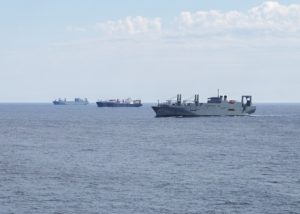A Department of Defense Inspector General (IG) audit found the Military Sealift Command (MSC) did not accurately report the readiness status of 15 surge sealift vessels from FY 2017-2018.
The report, Audit of Surge Sealift Readiness Reporting, determined MSC did not report the accurate readiness status of these surge sealift ships because it relied on ship contractors to report ship readiness. The IG’s office used 2017-2018 surge sealift readiness reports from the Defense Readiness Reporting System-Navy (DRRS-N) and Defense Readiness Reporting System-Strategic (DRRS-S).

This report was released internally on Jan. 22 and publicly released Jan. 24.
Surge sealift forces provide 90 percent of the cargo space needed to meet OPLAN requirements. The DoD IG said that translates into one ship being unable to perform its mission may mean an armored combat brigade combat team’s equipment would not be delivered when expected.
The audit said MSC officials told the DoD IG “they believed that the ship’s captains were in the best position to assess the ability of the ship to meet mission requirements, and therefore the MSC did not have procedures to verify that ship inspection reports matched casualty reports or to reconcile ship casualty reports to the DRRS-N ship readiness status.”
Since MSC’s ship readiness reporting was inaccurate, U.S. Transportation Command’s assessment of surge sealift capability was, therefore, unreliable, the report said.
This “could lead geographic combatant commanders to make incorrect assumptions about the initial availability of equipment and resupply of critical items.”
The report also found Maritime Administration (MARAD) contractors did not follow MSC criteria for assessing and reporting the readiness status of MARAD-owned sealift ships because MSC did not establish standard reporting procedures with MARAD.
MSC also accepted MARAD readiness reporting in DRRS-N without conducting oversight to verify the reported readiness status.
While MARAD contractors followed assessment and reporting criteria from the contract with MARAD, that had different definitions than MSC’s criteria for rating categories. When the IG applied the MSC assessment to the MARAD ships, it then found inaccuracies in the reported readiness status.
“For example, one MARAD ship had a deficiency identified in April 2018 that would have resulted in a not-available rating under the MSC criteria, but MARAD reported the ship as available for 99 days in DRRS-N,” the report said.
The report said, due to these inconsistencies, the Defense Department had to spend $478 million from FY 2016-2018 on maintenance and repairs of the 35 MARAD surge sealift ships and plans for another $844 million from FY 2019-2022. Moreover, the department is not verifying the surge sealift ships are being maintained at levels expected to be mission ready when required, the IG said.
The IG recommended the commander of MSC establish policies to verify deficiencies found in ship inspection reports match corresponding contractor-issued casualty reports, hold contractors accountable when the casualty reports do not match ship inspection reports or are not submitted as required, and reconcile casualty reports to the ship’s reported status in DRRS-N for accurate ship readiness reporting.
It also recommended the commander develop a process agreement with MARAD to establish standard criteria for readiness assessments for MSC and MARAD surge sealift ships as well as develop an oversight plan to verify the readiness status of MARAD ships and coordinate with MARAD to gain documentation and establish processes needed for MSC to perform oversight.
While the TRANSCOM chief of staff responded to the report for the commander of MSC and largely agreed with the recommendations, it did not address all specifics in the recommendations. Therefore, the IG disagrees all of the actions the chief of staff outlined will improve every issue identified.